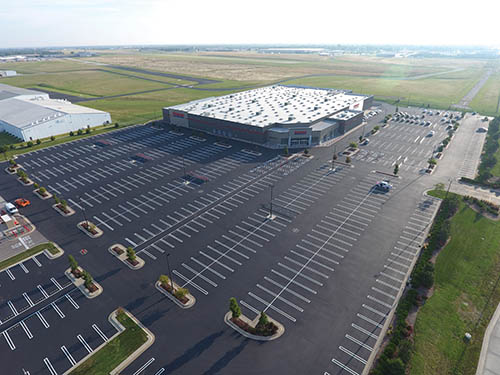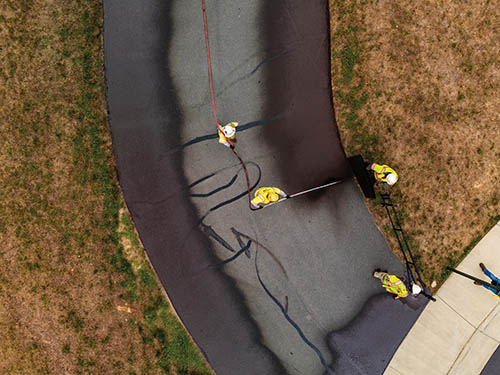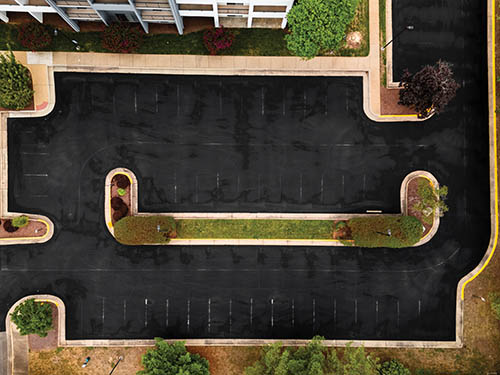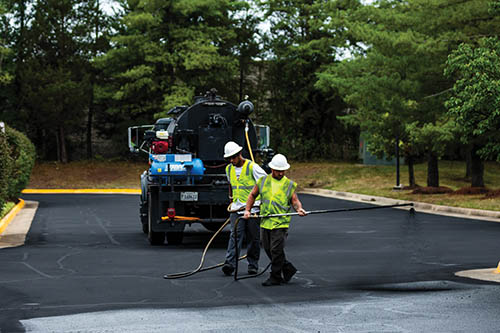— By Chuck Jeffries —
Paving the way for better facility management: why proactive maintenance is a game changer.
In retail and restaurant facilities, paved surfaces like parking lots, walkways and service areas often take a backseat to other priorities — until there’s a problem. But these areas are more than just asphalt and concrete. They’re critical to the customer experience, employee safety and day-to-day operations.

Too often, maintenance becomes a reactive exercise — patching up damage after it’s already created headaches. The smarter approach? Planning ahead with proactive maintenance services like crack sealing, sealcoating, patching & pothole repairs and re-striping help extend pavement life, improve curb appeal and reduce costly surprises.
Reactive vs. Proactive: A Quick Breakdown
Reactive maintenance is all about putting out fires. Repairs only happen when something goes wrong — like a pothole gets big enough to trip a pedestrian, or poor drainage causes a slip hazard near a service entrance. This approach usually involves chaotic scheduling, longer downtime and higher repair bills.
Proactive maintenance, on the other hand, is based on preparation. It means organizing regular inspections, planning for seasonal work and catching small problems before they escalate. It’s an investment in uptime, safety and peace of mind.
Why Preventative Maintenance Pays Off
Preventative maintenance is a game changer because it transforms pavement care from a stress-inducing scramble into a streamlined, strategic process that actually saves time and money in the long run.
Partnering with a contractor who can handle the inspections, budgeting and planning for you — while working around your schedule — makes it a seamless experience that lets you focus on running your facility, not reacting to pavement problems.
Keeps Things Running Smoothly
Avoiding downtime is critical in busy environments. Regular maintenance keeps your lot and walkways safe and accessible — reducing interruptions for tenants and customers alike.
Saves Money Over Time

Fixing cracks early or resealing pavement before it degrades can prevent the need for full replacements down the road. Routine care is far less expensive than major reconstruction.
Boosts Curb Appeal and Property Value
A clean, safe and freshly striped lot makes a strong first impression. Well-maintained pavement supports tenant retention and sends the message that the property is managed with care.
When Maintenance Stops, Damage Starts
When preventative maintenance is put on the back burner, small issues don’t stay small for long. Without a consistent plan in place, even low-traffic areas can quickly develop problems that impact safety, appearance and performance.
Cracks and potholes are some of the most obvious signs of neglected pavement. They often develop from unchecked wear due to weather and traffic — or from skipped routine repairs. Left untreated, these problems worsen fast, causing damage to vehicles and creating liability risks for pedestrians.
Drainage problems typically occur when regular inspections and upkeep are overlooked. Improper grading, clogged drains, and worn-out base materials lead to standing water, which accelerates erosion and undermines the pavement’s foundation.

Surface wear and fading are gradual issues caused by UV exposure, traffic and seasonal weather shifts. When sealcoating and surface treatments are delayed or skipped, the pavement loses its protective layer, resulting in a dull appearance, reduced traction and faster aging.
Get Ahead with Seasonal Pavement Planning
Not all months are created equal when it comes to pavement work. Dry, mild weather is best for repairs or repaving — think late spring or early fall. Cold temperatures and heavy rain can impact material performance and delay timelines.
Inspections should happen annually at minimum, and ideally after severe weather events. For routine maintenance like sealcoating and crack filling, a 3- to 5-year cycle is typically recommended. Planning your pavement maintenance projects in advance can help make sure your project is scheduled during optimal weather.
Budgeting for Success

One of the biggest mistakes businesses make is waiting until a repair becomes urgent — and then scrambling for budget. Planning ahead spreads out costs and reduces stress. Setting aside funds for maintenance each year helps avoid large, unexpected capital expenses.
Long term pavement plans should factor in the age of your surface, regional climate, usage level and past repair history. That way, you can address issues before they get expensive.
Facility Management Tools Make a Difference
Facility management software (FMS) makes it easier to stay organized, monitor conditions across multiple properties and track your maintenance ROI. These tools help teams respond faster, communicate clearly and plan smarter. They also support better documentation — useful for budgeting, compliance and reporting.
Preventative Pavement Maintenance isn’t Glamorous — But it’s Essential.
One multi-site retail property recently implemented a proactive pavement management plan across its portfolio. By dividing the work into phases over 3 years, they addressed aging lots before issues snowballed — saving an estimated 28% over what reactive repairs would have cost. Even better, the work was scheduled around peak shopping seasons, minimizing tenant disruption and avoiding revenue loss.
Preventative maintenance protects your investment, keeps your site safe and makes the property look good doing it. A proactive approach doesn’t just fix what’s broken — it helps you stay ahead of the curve.
— Chuck Jeffries is the CEO of Pave America National Services. With decades of executive leadership experience and a proven track record in the asphalt and concrete industry, Jeffries is passionate about helping property and facility managers implement smart, long term solutions. Under his leadership, the National Services division partners with clients across the country to deliver reliable, strategic pavement maintenance plans that protect investments and prioritize performance.

